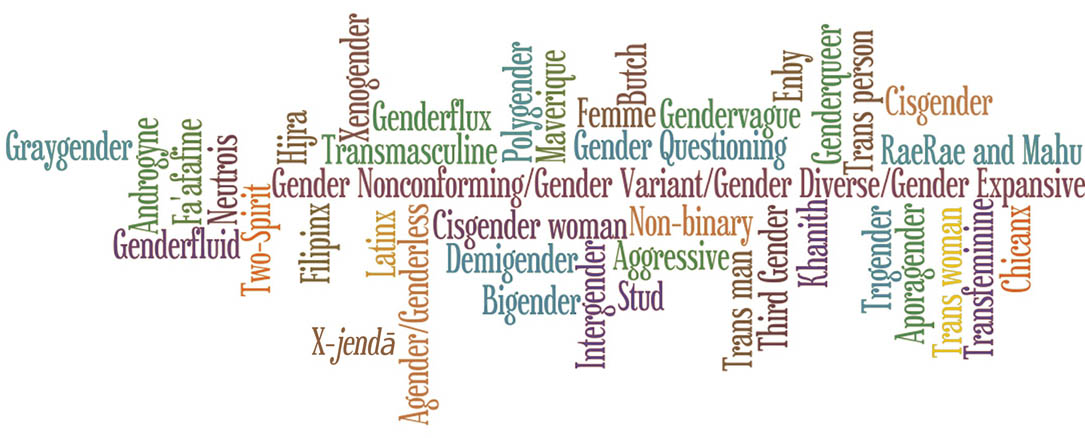
In this chapter, we will explore ways to use inclusive language when exchanging ideas and communicating with other people. How does EDI language evolve overtime? How can we use inclusive terminology when addressing LGBTQ2SIA+ (Lesbian, Gay, Bisexual, Transgender, Queer, Two-Spirit, Intersex, and Asexual) individuals? What are some of the guiding principles?
Learning Objectives
By the end of this chapter, you will be able to:
- Demonstrate how to use inclusive language;
- Use appropriate LGBTQ2SIA+ terminology and pronouns; and
- Explain how to follow the lead of equity-deserving groups in defining their own preferred use of language.

Introduction
Language is a communication system that is based on words, gestures, music, and artistic creations to connect with other people. It dates back thousands of years, long before the emergence of the first civilization, and has a remarkable amount of variety in terms of distinguished alphabet, vocabularies, and dialects. Language is vital for human connection as it allows us to express our feelings, thoughts, build relationships, and is part of each unique culture. The language we use today is an evolved product that reflects historical, social, economic, and cultural processes, and therefore, is vulnerable to biases and social stereotypes. For example, historically, all positions of power were occupied by men, such as congressman, policeman, fireman. However, these days, we use gender-neutral language as a standard practice to refer to a member of congress, police officers and firefighters. This movement towards inclusive language aims to ensure that all members of society are respected and valued. Inclusive communication is a powerful anti-oppression tool to build a sense of belonging that is free from patronizing stereotypes and discriminatory descriptors.

General Principles
The following principles are adapted from inclusive language style guides produced by Queen’s University and the University of Victoria.
- Person-centered language. We need to avoid descriptors and focus on mentioning individual identity and characteristics that are relevant to a story. For example, avoid saying “the Jewish students”, and instead use a person-centered language such as “the exchange students from Israel”. Similarly, instead of saying “a disabled person” say “a person with a disability”. When referring to abilities/disabilities, we need to put emphasis on the person (e.g., student/staff/faculty member with a disability, a person who has epilepsy, person living with schizophrenia), and use language that conveys a positive capability rather than focusing on their limitations and disabilities. Be sensitive that chronic conditions and disability can be both visible and non-visible.
- Gender-Neutral language. Use words such as “partner”, “parent”, “care-giver”, “employee”, “first-year students”, and avoid terms with “man”, such as “chairman”, “mankind”, “ombudsman”, “sportsman”, “guys”, etc. A classic example is the evolution of popular Star Trek phrase from the “Where No Man Has Gone Before” in the original series to “Where No One Has Gone Before” in Star Trek: The Next Generation.
- Remember the difference between in-group and out-group naming, and that certain reclaimed, once-derogatory terms, may only be appropriate to be used for those belonging to the same group. For example, the word “queer” historically meant strange or peculiar. As a reclaimed umbrella term, the term queer is now proudly used by individuals within the LGBTQ2SIA+ community.
- Avoid using stereotypic descriptors that relates to people’s identity, such as “bossy”, “lady Doctor”, “male nurse”’ and do not make assumptions based on individual’s physical characteristics.
- Be respectful of diverse backgrounds and perspectives and make conscious effects to guide your language by the preference of those concerned.
We need to keep in mind that language can evolve quickly so it is important to keep your vocabulary up to date. We also need to be mindful that not everybody shares the same principles. You should make an active effort to ensure your language follows the preference of your audience groups.

Inclusive Language for the LGBTQ2SIA+ Community
Before we introduce you to the proper way to address members from the LGBTQ2SIA+ Community, let us first take a minute to review all the important terminologies. The acronym LGBTQ2SIA+ is based in White, Western gay culture and has evolved to celebrate the diversity of its community. The full acronym is Lesbian, Gay, Bisexual, Transgender, Queer/Questioning, 2Spirit, Intersex, Asexual/Aromantic, + many other gender identities and sexual orientations (the 519, 2020). The word cloud that follows includes many terminologies used by the LGBTQ2SIA+ community. See the Transcript and Definitions for more details.

Transcript and Definitions: LGBTQ2SIA+ Word Cloud
The following definitions have been adapted from the University of Guelph’s Positive Space Training – Part 1 online module (the 519, 2016, 2020).
- Sex Assigned at Birth is what someone – usually a doctor or midwife, but occasionally in consultation with whoever birthed you – assigned you as when you were born. This is usually exclusively male or female and is based on your sex attributes (i.e., your genitals). Sometimes, a baby might be assigned intersex if the doctor was unable to determine the baby’s sex. When this happens, doctors would likely follow up with further testing to determine the sex of the baby.
- Sex is determined by individual biological makeup that include internal and external genitalia, chromosomes, hormones, and secondary sex characteristics (for example breasts, body hair, hip width). Many of these characteristics are not visibly apparent on some people, and a few of them are not apparent until after people are much older (i.e., during or after puberty). The different sex categories (male, female, and intersex) are on spectrums, as some people have a combination of different characteristics.
- Gender identity is someone’s internal sense of themselves or whom they know themselves to be. People might also identify with just one gender, or parts of many different genders (e.g., Man/Boy, Woman/Girl, and Other Gender such as agender or non-binary). Sometimes, people’s gender identity aligns with their assigned sex, but this is not always the case. When people’s gender identity and expression correspond with their sex, they are cisgender. When people’s gender identity and expression are different than their sex, they are transgender.
- Gender expression is how someone expresses their gender to the world through their choice of clothing, hairstyle, makeup preference, the way the talk, or their interests. Gender expression (Masculine, Feminine, and Androgynous/Other) does not necessarily align with gender identity for reasons such as access, comfort, or safety. For example, a man might have long hair and wear makeup, but still self-identifies as a man. Therefore, we cannot tell someone’s gender identity just by looking at them.
- Sexual orientation is to whom someone is attracted sexually. Identities commonly associated with sexual orientation include straight, gay, lesbian, and/or bisexual. Romantic orientation is to whom someone is attracted romantically. This is a less common term that describes who you want to engage with in romantic activities, such as cuddling, dating, or holding hands. Some people are sexually and/or romantically attracted to one gender identity, others are attracted to multiple genders. Romantic and sexual orientation do not necessarily align either. For example, someone might be romantically attracted to people of all genders, but only sexually attracted to men.
It is important to remember that sex assigned at birth, sex, gender identity, gender expression, sexual orientation, and romantic orientation are five distinct aspects of people. They all exist on spectrums and are not always consistent. These spectrums are complex, diverse, and very personal.
LGBTQ2SIA+ Vocabulary
The vocabulary used in LGBTQ2SIA+ Community is an exemplary demonstration of how quickly our language changes. As our society starts to respect and appreciate the diverse genders and orientations, our language evolves to be more inclusive and respectful. For example, inclusive terminology “Gay” or “Lesbian” is now used instead of “homosexual” that stigmatized individuals in the LGBTQ2SIA+ community. Language around a trans person has also evolved rapidly in the past few decades, and stigmatized words, such as transsexual, transgenderism, tranny, Male-to-Female (MTF) or Female-to-Male (FTM), sex reassignment surgery/treatment should all be avoided. Instead, trans is the current umbrella term, and the procedures that help people transition to their self-identified gender is called gender affirmation treatment or gender affirmation surgery. Keep in mind that all individuals are their unique and authentic self and should always be addressed by their preference.

Pronouns
An effective way to acknowledge people’s gender identities is through the use of pronouns. A pronoun is a part of speech that replaces a place, idea, object, and emotion, such as “it”, “this”, “those” (i.e., instead of “this apple is very sweet”, we would say “it is very sweet”). Pronouns can also be used to reflect people’s gender identity. Most common forms of pronouns include He/Him/His/Himself, She/Her/Hers(s)/Herself, and gender-neutral pronoun They/Them/Theirs/Themself/Themselves. Although there are forms of pronouns such as Ze, Ve, Xe, Ey, Fae, the key is not to remember every single gender pronoun, but to respect how people self-identity.
Watch this short video (1:35) CBC Kids News to explore what pronouns are and how to use them in our everyday life: Pronouns like she/her, he/him and they/them explained
Practicing Pronouns

Summary and Self-Reflection
Tip #6
Use inclusive language and monitor changing EDI language.
Language is powerful. It can make or break a person. In our everyday life, what we say or do, and how we say or do, makes a big difference for people around us. Inclusive language can make people feel welcome, encouraged, respected, and supported. On the contrary, when we do not make an active effort to ensure all members are included, we are missing out on diverse perspectives and unique talents. As you continue your learning, it is important to reflect and ask yourself:
- Did you talk to people the way you want to be talked to?
- Were you using positive and neutral language regardless of people’s identity and characteristics?
- Did you address people the way they preferred?
- Did you use plain and accessible language rather than complicated acronyms or jargon?
- Did you acknowledge the diversity of your audience and use appropriate pronouns?
Additional Resources
Chapter 6 References
Queen’s University. Style guide: Inclusive Language Guidelines. Retrieved December 1, 2021, from https://www.queensu.ca/styleguide/inclusivelanguage
The 519. (2016). Media Reference Guide – Discussing trans and gender-diverse people.
The 519. (2020). LGBTQ2S Glossary of Terms.
The University of Victoria. (2020). Style guide: Inclusive Language. Retrieved December 1, 2021, from https://www.uvic.ca/brand/story/style/inclusivity/index.php#2
Image Credits
Chapter 6 Banner: Open Learning and Educational Support, University of Guelph/graphic
Chapter 6 Divider: Open Learning and Educational Support, University of Guelph/graphic
Figure 6.1 LGBTQ2SIA+ Word-cloud: Open Learning and Educational Support, University of Guelph/graphic
